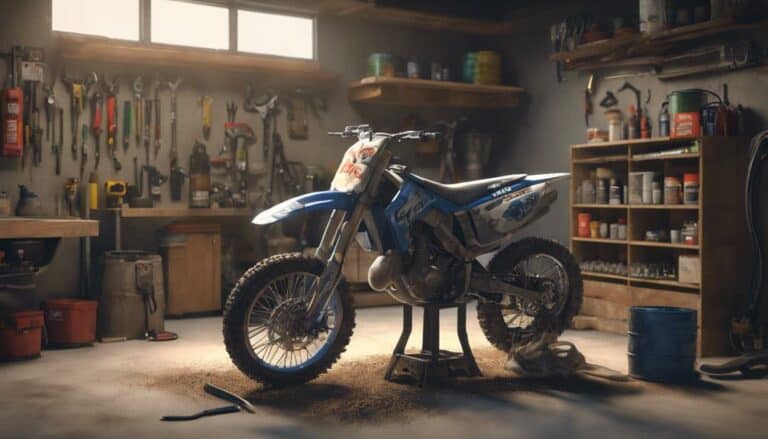When it comes to maintaining your dirt bike, the question of whether to tackle an oil change at home or seek professional help may linger in your mind. While the idea of handling the task yourself might seem challenging at first, with the right guidance and preparation, you may find that DIY oil changes offer more benefits than you initially thought.
But before you grab your tools and start draining oil, there are essential aspects to think about that could impact the overall health of your bike's engine.
Key Takeaways
- DIY oil changes offer control, cost savings, and skill development.
- Essential tools include oil, filter, pan, funnel, and wrenches.
- Follow steps like warming engine, draining oil, and refilling correctly.
- Seek professional help for technical challenges or warranty requirements.
Benefits of DIY Dirt Bike Oil Change
When considering the benefits of a DIY dirt bike oil change, you gain control over the maintenance process, ensuring efficient upkeep of your machine. Conducting an oil change at home allows you to adhere strictly to maintenance intervals, a critical aspect in preserving the health of your dirt bike's engine.
By taking on this task yourself, you not only save on time and money but also develop essential mechanical skills that can come in handy for other bike maintenance needs. Opting for high-quality oils and filters tailored to your bike's requirements enhances its performance and longevity.
Additionally, DIY oil changes enable you to personalize the process by incorporating additional checks and inspections to guarantee your dirt bike's overall well-being. Embrace the liberation that comes with mastering this fundamental maintenance task, and enjoy the satisfaction of knowing your bike is in top shape under your attentive care.
Tools Needed for Dirt Bike Oil Change
To efficiently perform a dirt bike oil change, you'll need specific tools such as oil, an oil filter, an oil pan, a funnel, and suitable wrenches. These tools are essential for maintaining your dirt bike engine's health and performance. When conducting an oil change, having the right tools guarantees a hassle-free process and helps you adhere to manufacturer guidelines.
A clean work area paired with quality tools is vital for a successful DIY oil change at home. One particularly handy tool is an oil filter wrench, which can simplify the removal and replacement of the oil filter.
Step-by-Step Guide to Changing Dirt Bike Oil
For best results in changing your dirt bike oil, make sure you gather all necessary tools and supplies before beginning the process.
Follow these steps to successfully change the oil in your dirt bike:
- Warm up the engine: Start your dirt bike and let it run for a few minutes to warm up the oil. This helps in better flow and suspension of contaminants.
- Drain the oil: Locate the drain plug underneath the engine and place the oil pan beneath it. Unscrew the plug and let all the old oil drain out completely.
- Replace the oil filter: Remove the old oil filter using a filter wrench. Install a new oil filter by lubricating the gasket with fresh oil and tightening it securely.
- Refill with new oil: Consult your owner's manual for the recommended oil type and quantity. Use a funnel to pour the new oil into the engine, ensuring it reaches the correct level.
Common Mistakes to Avoid During Oil Change
Making mistakes during a dirt bike oil change can lead to costly repairs and performance issues if not addressed properly. To guarantee a successful oil change, avoid over-tightening the drain plug, as it could damage the oil pan threads. Always use the proper oil filter size and type recommended by the manufacturer for peak filtration. Make sure the O-ring on the oil filter is correctly seated to prevent oil leaks. Dispose of used oil and filters responsibly at certified recycling centers to safeguard the environment. Finally, double-check the oil level after refilling to prevent under or overfilling the engine, which can cause damage. Following these steps will help you maintain your dirt bike's engine health and performance.
| Common Mistakes to Avoid During Oil Change | ||
|---|---|---|
| Over-tightening | Use of Correct Oil Filter | Proper Seating of O-ring |
| Responsible Disposal of Used Oil | Double-Check Oil Level |
When to Seek Professional Help for Oil Change
If you encounter challenges with technical aspects or lack the necessary tools, seeking professional help for a dirt bike oil change is a prudent decision. Here are some situations where it's best to opt for professional assistance:
- Essential: If you're unfamiliar with the intricacies of dirt bike maintenance, professional help can guarantee the job is done correctly.
- Ensure: Without the proper tools, achieving a successful oil change can be challenging. Professionals have the necessary equipment for a seamless process.
- Best: Ensuring the right amount of oil is essential for the best engine performance. Professionals can guarantee precise measurements.
- Optimum: Some manufacturers require oil changes to be performed by certified professionals to maintain warranty coverage. Seeking professional assistance can help you adhere to these requirements and safeguard your warranty.
Conclusion
To sum up, performing a dirt bike oil change at home isn't only cost-effective but also a rewarding task for riders. By following the step-by-step guide and ensuring you have the right tools, you can easily maintain your dirt bike's engine health without professional assistance.
So, why wait? Take charge of your bike's maintenance and experience the satisfaction of a job well done. When will you start your next DIY oil change?

